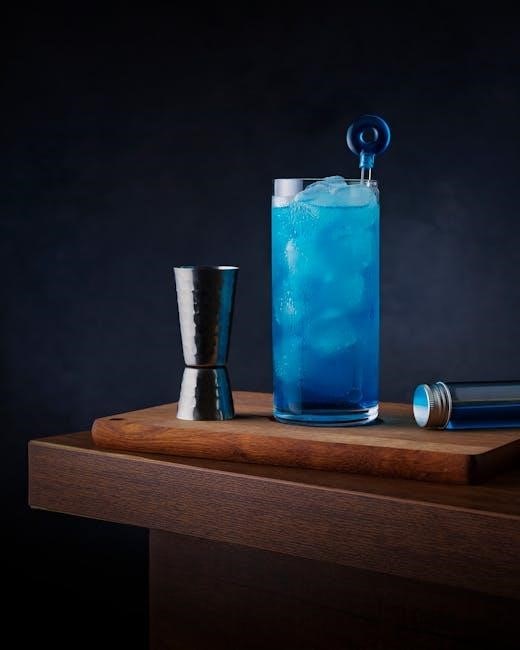Bartending terminology is the foundation of professional mixology‚ enabling clear communication between bartenders‚ suppliers‚ and customers. Understanding key terms enhances creativity and efficiency behind the bar‚ ensuring precision in crafting cocktails. From basic phrases like “Highball” to advanced techniques‚ mastering this language is essential for both beginners and experts. It also simplifies ordering and preparation‚ fostering a seamless workflow in busy environments. This guide explores the essential vocabulary‚ techniques‚ and tools‚ providing a comprehensive resource for aspiring and seasoned bartenders alike. Learning these terms is the first step toward mastering the art of mixology and delivering exceptional drinks.
Overview of Bartending Terminology
Bartending terminology encompasses a wide range of terms‚ phrases‚ and concepts essential for understanding the art of mixology. From basic terms like Highball and Dry to advanced techniques‚ this terminology forms the backbone of communication in the bar industry. It includes tools‚ techniques‚ spirits‚ and measurements‚ ensuring consistency and clarity in drink preparation. These terms are vital for professionals and enthusiasts alike‚ providing a universal language that facilitates creativity and precision behind the bar.
Importance of Understanding Bartending Terms
Understanding bartending terminology is crucial for effective communication and consistency in drink preparation. It ensures precision in mixing techniques‚ enhances customer satisfaction‚ and streamlines workflow. Clear knowledge of terms like Proof‚ Neat‚ and Rocks prevents misunderstandings and elevates professionalism. Whether you’re a novice or an expert‚ mastering these terms fosters creativity and efficiency‚ making it an indispensable skill for anyone passionate about mixology and aiming to excel in the bartending world.
Essential Bartending Terms and Definitions
Common bartending phrases like On the Rocks‚ Neat‚ and Dirty are essential for clear communication. These terms describe how drinks are prepared‚ ensuring accuracy and customer satisfaction. Mastering these phrases enhances efficiency and professionalism‚ making them a cornerstone of effective bartending practice and customer interaction.
Common Bartending Phrases
Common bartending phrases like On the Rocks (served over ice)‚ Neat (undiluted)‚ and Dirty (with added ingredients like olive brine) are fundamental. Terms like Highball (a spirit with soda) and Chaser (a post-shot drink) streamline ordering. Understanding phrases like Dry (minimal vermouth in martinis) or Double (twice the alcohol) ensures precise drink preparation. These phrases are essential for clear communication between bartenders and patrons‚ enhancing efficiency and customer satisfaction.
Key Terms for Beginners
Familiarizing yourself with basic bartending terms is crucial. A Spirit is the alcoholic base‚ while a Mixer adds flavor without alcohol. Shake combines ingredients with ice‚ and Stir mixes without ice. Strain separates liquids from solids‚ and a Garnish enhances presentation. Rim involves coating the glass edge. Understanding these terms aids in creating balanced and visually appealing cocktails‚ essential for any aspiring bartender.
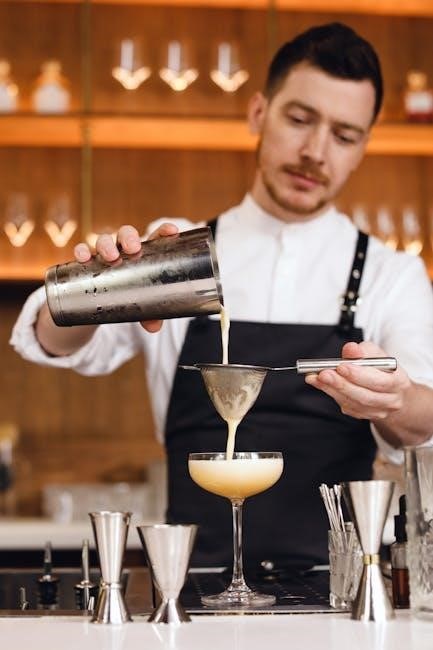
Understanding Bartending Techniques
Mastering essential techniques like shaking‚ stirring‚ and muddling is vital for crafting cocktails. These methods ensure proper mixing‚ dilution‚ and flavor extraction‚ while garnishing enhances presentation‚ making drinks visually appealing and refined.
Basic Mixing Techniques
Basic mixing techniques are fundamental to bartending‚ ensuring drinks are well-balanced and visually appealing. Shaking combines and chills ingredients‚ while stirring dilutes and maintains clarity. Muddling releases flavors from fruits or herbs‚ and garnishing adds a finishing touch. These methods require precision to achieve the perfect texture and presentation‚ making them essential skills for every bartender to master. Proper execution elevates both the taste and aesthetic of cocktails‚ creating a memorable experience for customers.
Advanced Bartending Methods
Advanced bartending methods elevate mixology to an artistic level‚ incorporating innovative techniques like spherification‚ foamification‚ and smoking. These methods enhance flavor profiles and presentation‚ creating unique sensory experiences. Tools such as centrifuges and vacuum sealers are used to extract essences and infuse flavors. Techniques like fat washing and molecular gastronomy redefine traditional cocktails‚ offering complexity and creativity. Mastery of these methods distinguishes professional bartenders‚ enabling them to craft truly exceptional drinks that captivate discerning palates and push the boundaries of modern mixology.
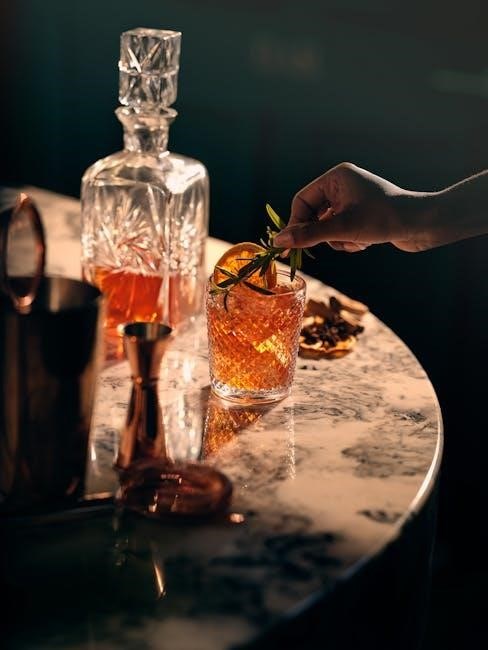
Bartending Tools and Equipment Terminology
Boston shaker‚ jigger‚ muddler‚ hawthorne strainer‚ and bar spoon are essential tools for mixing and measuring ingredients. Each tool serves a specific purpose‚ ensuring precision and efficiency behind the bar.
Essential Bar Tools
The Boston shaker‚ jigger‚ and muddler are fundamental tools for bartenders. A Boston shaker is used for mixing and chilling ingredients‚ while a jigger measures precise liquor amounts. The muddler crushes fruits and herbs‚ releasing flavors. Other key tools include the hawthorne strainer for filtering cocktails and the bar spoon for stirring. These tools ensure efficiency and consistency in preparing high-quality drinks‚ making them indispensable for professionals and home bartenders alike. Mastering these tools is the first step in elevating your bartending skills.
Specialized Equipment for Professional Bartenders
Professional bartenders often utilize advanced tools like blenders for frozen cocktails‚ smokers for infusing smoky flavors‚ and sous vide machines for precise temperature control. Additionally‚ nitrogen infusers and vacuum mixers are used for molecular mixology techniques‚ creating unique textures and presentations. These specialized tools allow bartenders to innovate and elevate their craft‚ offering distinctive experiences for discerning patrons. While not essential for every bar‚ they are valuable for those aiming to push creative boundaries in mixology.
Bartending Jargon and Slang
Bartending jargon includes terms like jigger (a measuring tool)‚ muddle (to crush ingredients)‚ and rim (dipping glass edges in flavorings). These terms are essential for clear communication and efficient mixing.
Common Phrases Used Behind the Bar
Common phrases behind the bar include “Last call!” signaling final orders‚ “On the rocks” for drinks over ice‚ and “Neat” for undiluted spirits. Bartenders also use “Twist” for citrus peels and “Muddle” to crush ingredients. These terms ensure efficiency and clarity‚ streamlining service during busy shifts. Understanding them enhances communication and helps deliver precise drinks‚ making them indispensable for both professionals and home bartenders alike.
Industry-Specific Slang
Industry-specific slang includes terms like “Well drinks” for house spirits‚ “Call drink” for premium brands‚ and “Finger” to measure liquor pours. “Jigger” refers to a measuring tool‚ while “Mudslide” describes a chaotic bar scene. These terms are unique to bartending‚ fostering quick communication among professionals. Understanding them enhances workflow and camaraderie‚ making them essential for navigating the fast-paced environment of a professional bar setting effectively.
Terminology Related to Glassware and Serveware
Terminology for glassware includes Highball‚ Old Fashioned‚ Martini‚ and Coupe glasses‚ each designed for specific cocktails. Serveware terms like rim and stem describe glass parts‚ essential for presentation and functionality in bartending.
Types of Glassware for Cocktails
Cocktail glassware includes Highball and Old Fashioned glasses‚ designed for tall drinks and whiskies‚ respectively. The Martini glass‚ with its iconic cone shape‚ is perfect for showcasing clear cocktails. Coupe glasses are ideal for serving intricate mixes‚ while Margarita glasses feature a salted rim for classic recipes. Each glass type enhances the visual and sensory experience of the cocktail‚ making them essential tools for bartenders to elevate their creations.
Proper Serveware Terminology
In bartending‚ serveware terminology refers to tools and items used to prepare and present drinks. A garnish enhances flavor and aesthetics‚ while a rim refers to the glass edge‚ often coated with salt or sugar. A muddler crushes ingredients‚ and a jigger measures precise liquor amounts. Terms like chaser describe a mixer consumed after a shot. Understanding these terms ensures efficient service and professional presentation‚ elevating the bartending experience for both creators and consumers.
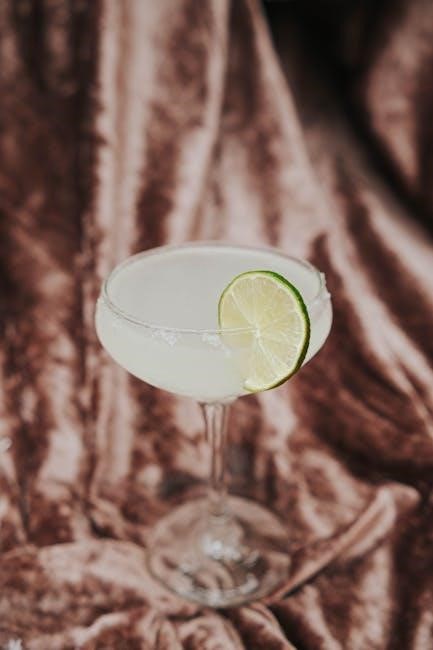
Bartending Measurements and Ratios
Accurate measurements are crucial in bartending‚ using tools like a jigger to ensure precise pours. Standard ratios‚ such as 2:1 for mixers to spirits‚ ensure balanced flavors. Terms like dash and pinch describe small quantities‚ while neat and straight up specify serving styles without mixers or ice. Understanding these ratios and terms is vital for crafting consistent‚ high-quality cocktails.
Understanding Measurements in Bartending
Accurate measurements are critical in bartending to ensure consistent flavors. Tools like a jigger or measuring cup are essential for precise pours. Common terms include dash (a small amount)‚ pinch (a tiny quantity)‚ and ounce (a standard measurement). Techniques like free-pouring rely on experience‚ while ratios guide mixer-to-spirit proportions. Understanding these measurements ensures balanced‚ high-quality cocktails‚ making it a cornerstone of professional bartending. Precision is key to mastering mixology and delivering exceptional results.
Standard Ratios for Mixing Drinks
Standard ratios simplify drink preparation‚ ensuring consistency and balance. Common ratios include 1:3 (spirit to mixer) for highballs‚ 2:1 (booze to sweet/sour) for classics like the Daiquiri‚ and 1:1 (spirit to sweet) for simple syrups. The 2:1:1 ratio (spirit‚ sweet‚ sour) is ideal for three-ingredient cocktails. These ratios serve as a starting point‚ allowing bartenders to adjust flavors while maintaining harmony. Understanding them enhances creativity and ensures perfectly balanced drinks every time.
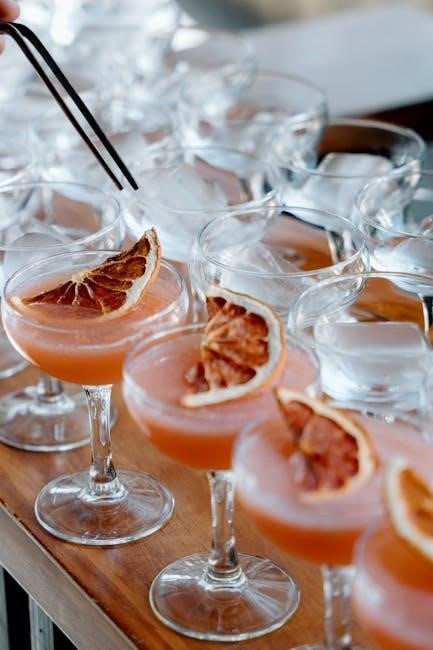
Glossary of Spirits and Liqueurs
A spirit is a distilled beverage with high alcohol content‚ like vodka‚ rum‚ or gin. Liqueurs are sweet‚ flavored liquids used in cocktails‚ such as triple sec or Kahlúa. Both are essential in mixology‚ adding unique flavors and complexity to drinks. Understanding their profiles and roles enhances cocktail creation and balance. Digestifs are enjoyed after meals‚ aiding digestion. Double refers to a drink with twice the standard alcohol. These terms are vital for crafting diverse beverages. Proof measures alcohol strength‚ with 100 proof being 50% alcohol. This glossary provides a clear guide to these key ingredients. Sundries are small‚ flavorful pastries often served in bars. Chaser is a mixer consumed after a shot. These definitions help bartenders communicate effectively and create exceptional drinks. Back up means serving the same drink again. Brut describes dry Champagne. Call drink is a bartender’s term for a drink made with a specific brand. These terms are fundamental for professional bartending. Highball is a drink with one spirit and one mixer. On the rocks means serving a drink over ice. Dry refers to minimal vermouth in a martini. This glossary covers essential terms for both beginners and experts. Distillation is the process of producing spirits. Long Products include stainless steel rods and bars used in equipment. Supplement means adding something extra to a drink. Stocking a home bar involves having basic spirits and mixers. The Professional Bartender requires a deep understanding of these terms. A Bartenders Glossary is a valuable resource for learning these terms. Bar Basics include knowing common terms like Chaser and Highball. Standard Ratios ensure balanced flavors in cocktails. Common Bar Terms are essential for clear communication in the industry. Bartending Terminology is the language of mixology‚ aiding creativity and efficiency. Understanding Measurements and Standard Ratios is crucial for precise drink preparation. Advanced Bartending Terminology includes specialized terms for expert bartenders. Molecular Mixology introduces scientific techniques to cocktail creation. Resources for Learning include books and online guides. Final Thoughts emphasize the importance of mastering bartending terminology. bartending terminology pdf provides a comprehensive guide to these terms. Bartending Terminology is essential for both professionals and home bartenders. Learning these terms enhances your skills and knowledge in mixology. Bartending Terminology is the key to creating exceptional cocktails. Bartending Terminology is a vital part of the bartending process. Bartending Terminology ensures clarity and precision in every drink. Bartending Terminology is the foundation of professional bartending. Bartending Terminology is essential for any aspiring bartender. Bartending Terminology is the language of the bar. Bartending Terminology is crucial for success in the industry. Bartending Terminology is the first step to mastering mixology. Bartending Terminology is the heart of bartending. Bartending Terminology is the soul of the bar. Bartending Terminology is the essence of mixology. Bartending Terminology is the core of bartending. Bartending Terminology is the backbone of the bar. Bartending Terminology is the lifeblood of the industry. Bartending TerminologyCommon Spirits Used in Bartending
Vodka‚ rum‚ gin‚ tequila‚ and whiskey are cornerstone spirits in bartending‚ each offering unique flavors. Vodka is neutral‚ perfect for martinis‚ while rum adds tropical notes to cocktails like mojitos. Gin is botanical‚ starring in gin & tonics. Tequila is bold‚ essential for margaritas. Whiskey brings depth to old fashioneds. These spirits form the backbone of mixology‚ with their versatility and distinct profiles. They are detailed in the bartending terminology pdf as fundamental ingredients for classic and modern drinks.
Liqueurs and Their Roles in Cocktails
Liqueurs are sweet‚ flavored spirits used to enhance cocktails with unique tastes and textures. They add depth and complexity‚ serving as modifiers or key ingredients. Common liqueurs include triple sec‚ Kahlúa‚ and Grand Marnier‚ each offering distinct profiles. For example‚ triple sec brings citrus notes to margaritas‚ while Kahlúa adds coffee flavor to espresso martinis. These ingredients are essential for balancing and customizing drinks‚ as detailed in the bartending terminology pdf.
Advanced Bartending Terminology
Advanced bartending terminology includes specialized terms like molecular mixology‚ spherification‚ and foam‚ which describe innovative techniques enhancing cocktail creativity and presentation. These terms are explored in depth in the bartending terminology pdf.
Specialized Terms for Expert Bartenders
Specialized terms for expert bartenders include spherification‚ gelification‚ and emulsification‚ which refer to advanced techniques in molecular mixology. These methods allow bartenders to create unique textures and visual effects in cocktails. The bartending terminology pdf also covers terms like flash infusion and vacuum distillation‚ which are used to infuse flavors and preserve ingredients. Mastering these terms enhances a bartender’s ability to innovate and deliver cutting-edge drinks‚ setting them apart in the industry.
Terminology for Molecular Mixology
Molecular mixology involves spherification‚ gelification‚ and foamification‚ creating unique cocktail textures. Terms like hydrocolloid and emulsifier describe ingredients used to stabilize mixtures. Techniques like flash infusion and cryo-muddling enhance flavor extraction. Tools such as siphons and vacuum chambers are essential for precise preparation. The bartending terminology pdf details these methods‚ offering insights into innovative cocktail design and advanced mixology practices. These terms redefine traditional bartending‚ pushing creativity and scientific precision.
Resources for Learning Bartending Terminology
Discover comprehensive guides like Mr. Boston Official Bartenders Guide and online platforms offering bartending terminology PDFs. These resources provide detailed glossaries‚ techniques‚ and expert tips for mastering mixology.
Recommended Books and Guides
For in-depth learning‚ Mr. Boston Official Bartenders Guide is a timeless resource‚ offering detailed terminologies and classic cocktail recipes. The Bartender’s Glossary provides concise definitions‚ while Bar Basics and Terminology covers essential tools and techniques. These guides are perfect for beginners and professionals‚ ensuring a solid understanding of bartending fundamentals and advanced practices. They also include practical tips for refining skills and creating innovative drinks.
Online Resources for Bartending Education
Online platforms offer extensive resources for mastering bartending terminology. Websites like xwpx.iipc.lv provide detailed guides and glossaries. Mr. Boston Official Bartenders Guide is available in digital formats‚ offering comprehensive insights. Additionally‚ forums and educational sites like BarSmarts and The Mixology Guide provide interactive learning tools. These resources are invaluable for both beginners and professionals‚ ensuring up-to-date knowledge and skills in the ever-evolving world of mixology.
Final Thoughts on Mastering Bartending Terminology
Mastering bartending terminology is essential for professionals and home enthusiasts‚ enhancing communication and creativity. Continuous learning ensures growth in this dynamic field‚ where knowledge truly elevates the craft.
